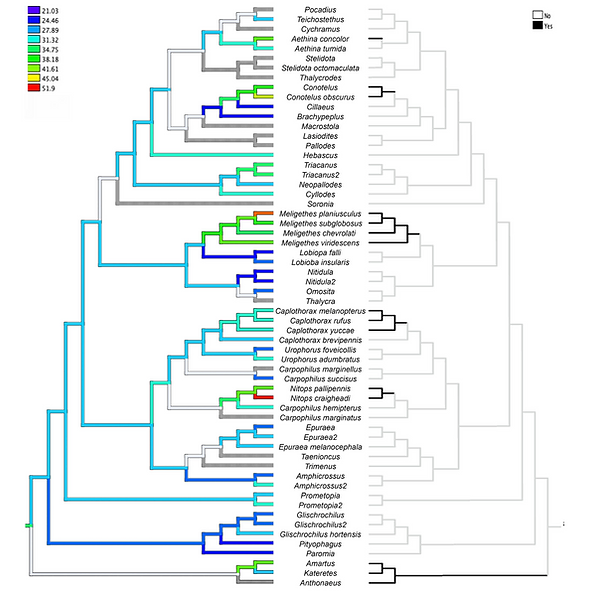
Publications
Selected publications and figures from the PIE Lab below.
For a complete list of publications, please visit Google Scholar.
Beetle bioluminescence outshines aerial predators
Gareth S. Powell, Natalie A. Saxton, Yelena M. Pacheco, Kathrin F. Stanger-Hall, Gavin J. Martin, Dominik Kusy, Luiz F.L. da Silveira, Ladislav Bocak, Marc A. Branham, Seth M. Bybee. (2022)
Proceedings of the Royal Society B
We understand very little about the timing and origins of bioluminescence, particularly as a predator avoidance strategy. Understanding the timing of its origins, however, can help elucidate the evolution of this ecologically important signal. Using fireflies, a prevalent bioluminescent group where bioluminescence primarily functions as aposematic and sexual signals, we explore the origins of this signal in the context of their potential predators. Divergence time estimations were performed using genomic-scale datasets providing a robust estimate for the origin of firefly bioluminescence as both a terrestrial and as an aerial signal. Our results recover the origin of terrestrial beetle bioluminescence at 141.17 (122.63–161.17) Ma and firefly aerial bioluminescence at 133.18 (117.86–152.47) Ma using a large dataset focused on Lampyridae; and terrestrial bioluminescence at 148.03 (130.12–166.80) Ma, with the age of aerial bioluminescence at 104.97 (99.00–120.90) Ma using a complementary Elateroidea dataset. These ages pre-date the origins of all known extant aerial predators (i.e. bats and birds) and support much older terrestrial predators (assassin bugs, frogs, ground beetles, lizards, snakes, hunting spiders and harvestmen) as the drivers of terrestrial bioluminescence in beetles. These ages also support the hypothesis that sexual signalling was probably the original function of this signal in aerial fireflies.

Diversity of color in pleasing fungus beetles (Coleoptera: Erotylidae: Erotylinae)
Rachel J. Sutherland, Eva Jasinski Driggs, Laura N. Sutherland, Paul E. Skelley, Seth M. Bybee, Gareth S. Powell. (2025)
Diversity
Erotylidae, or pleasing fungus beetles, are a morphologically diverse lineage of Coleoptera notable for the variety of colors and patterns present on their dorsal surface. This study begins the characterization of this diversity and discusses patterns around coloration within Erotylinae. Using spectrophotometer data, we investigated the frequency of certain color motifs across erotyline tribes and discuss geographic patterns in these color motifs. The most frequently observed colors within Erotylinae are brown/black with orange/red maculations in the case of bicolored taxa. In terms of type of maculations, stripes were the most common pattern observed. When summarizing the diversity across major geographic areas, the Neotropical and Indomalay regions displayed the most color variation, followed by the Australasian region.

Repeated feeding guild evolution: the impact of competition on diversification
Gareth S. Powell, Natalie A. Saxton, Alexandra G. Duffy, Stephen L. Cameron, Andrew R. Cline, Thomas C. McElrath, Matthew L. Gimmel, Jerald B. Johnson, Richard A.B. Leschen, Paul E. Skelley, Seth M. Bybee, Nicole L. Gunter. (2024)
Evolutionary Journal of the Linnean Society
Adaptive zones are defined as ecological opportunities for lineages to diversify. Cucujoid beetles provide a unique system to investigate adaptive zones, specifically the interplay between factors that may predict diversity and mechanisms such as competition that may limit diversification. Using a taxon-rich, time-calibrated phylogeny of cucujoid beetles, we report clade ages in conjunction with estimated ages for major shifts in feeding ecology within this group. With these ages, we calculate the delay in time-to-colonization of food resources compared with the extant diversity of each group. We uncovered a pattern of increased lineage diversity specifically with shifts to novel food resources probably devoid of competition from other cucujoid beetles. Neither diversity of the food resource, age of the food resource, nor age of the beetle lineage were able to predict species diversity of these groups. Our results provide evidence that shifting to a resource first is a strong predictor of extant diversity.

Gareth S. Powell, Seth M. Bybee. (2023)
Systematic Entomology
Patterns in morphological variation are a central theme of evolution. Uncovering links between morphological character evolution and natural history, specifically feeding behaviour, is important to understanding biological diversity. Species within the sap beetles (Nitidulidae) exhibit a tremendous diversity of feeding behaviours. This immense diversity of feeding can be seen both between major lineages and very closely related taxa. Feeding behaviour diversity may drive morphological variation in several character systems (e.g., eyes). For example, in a shift from feeding on rotting fruit to flower-visiting (anthophily), selective pressures on the visual system may vary and ultimately lead to differences in eye morphology. We tested for potential morphological shifts in relative eye size among adult beetles. We specifically tested for significant relationships between relative eye size and the following factors flower-visiting and sex. We also tested for the influence of phylogeny on the evolution of relative eye size, implementing tests of trait correlation across a topology. We found greater relative eye size in taxa exhibiting anthophilous behaviour, regardless of phylogenetic relatedness or feeding behaviour of sister taxa. We were unable to recover a relationship between relative eye size and sex. Thus, feeding behaviour is currently the strongest predictor of eye size in sap beetles.

All works can be found on Google Scholar.